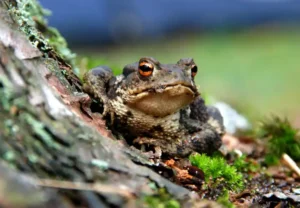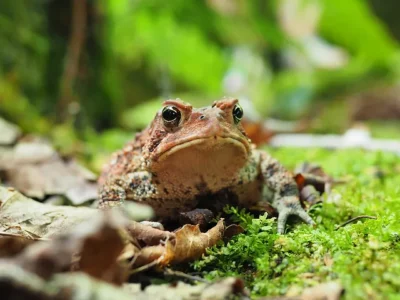Frogs, with their unique physiology and diverse habitats, exhibit fascinating behaviors when it comes to survival. One intriguing question that often arises among frog enthusiasts and pet owners alike is, How long can frogs go without food? Understanding the answer requires a closer look at the different species of frogs, their natural diets, and their ability to endure periods of fasting.
Whether you’re caring for a pet frog or studying these amphibians in the wild, knowing how long frogs can go without food is essential for ensuring their well-being and proper care. In this article, we’ll explore the factors that influence a frog’s ability to survive without food and offer insights into their dietary needs and survival strategies.
How long can frogs go without food?

The duration a frog can go without food depends on several factors, including its species, age, and overall health. Generally:
- Adult Frogs: Many adult frogs can survive for a few weeks without food, and some species can last up to a month or longer if they are well-hydrated and in good health.
- Tadpoles: Tadpoles have a higher metabolism and generally need more frequent feeding. They may survive only a few days to a week without food.
- Hibernation: Some frog species can enter a state of torpor or hibernation during colder months, during which their metabolic rate drops significantly, allowing them to go without food for extended periods.
It’s important to ensure frogs have a consistent diet and proper care to maintain their health. If you’re keeping frogs as pets, it’s best to avoid long periods without feeding and provide a varied diet suited to their species.
Factors Affecting a Frog’s Ability to Go Without Food
Several factors affect how long a frog can go without food:
- Species: Different frog species have varying metabolic rates and dietary needs. For example, some frogs can go longer without food than others. Aquatic frogs might have different requirements compared to terrestrial ones.
- Age: Juvenile frogs have higher metabolic rates and generally need to eat more frequently than adults. Adult frogs can often go without food for longer periods.
- Health: A frog’s overall health plays a crucial role. Healthy frogs with adequate fat reserves can survive longer without food, while sick or malnourished frogs will have a shorter survival period.
- Environmental Conditions: Temperature and humidity affect a frog’s metabolism. Frogs in cooler or more humid conditions may go longer without food, as their metabolic rates slow down. Conversely, high temperatures can increase their metabolic needs.
- Fat Reserves: Frogs that have stored up fat reserves from previous feeding can survive longer without food. Frogs with lower body fat may not last as long.
- Hydration: Proper hydration is crucial. Frogs that are well-hydrated can go longer without food than those that are dehydrated.
- Activity Level: Less active frogs will use less energy and can survive longer without food compared to more active ones. Frogs in a state of dormancy or torpor will also have reduced energy needs.
- Metabolic Rate: Frogs with higher metabolic rates will need food more frequently. Seasonal changes can affect metabolic rates, influencing how long they can go without food.
Understanding these factors can help ensure that frogs receive proper care and do not experience unnecessary stress or health issues related to food deprivation.
Typical Duration Frogs Can Survive Without Food
The typical duration a frog can survive without food varies based on several factors:
- Species:
- Aquatic Frogs: Frogs like African clawed frogs can often go several weeks without food.
- Terrestrial Frogs: Many terrestrial species, such as tree frogs, might also survive for a few weeks, but this can vary widely.
- Age:
- Juvenile Frogs: Generally, juvenile frogs require more frequent feeding and may only last a few days to a week without food.
- Adult Frogs: Adults can usually go for a longer period without food, often several weeks.
- Health:
- Healthy Frogs: In good health, frogs might survive for up to a month or more without food.
- Unhealthy Frogs: Sick or malnourished frogs may only last a few days to a week.
- Environmental Conditions:
- Cooler Temperatures: Frogs in cooler environments might survive longer without food due to reduced metabolic rates.
- Warmer Temperatures: Higher temperatures can increase their metabolic needs, reducing their survival time without food.
- Hydration:
- Well-Hydrated Frogs: Proper hydration can extend a frog’s ability to go without food. Hydrated frogs may survive a bit longer.
- Dehydrated Frogs: Dehydrated frogs will not survive as long without food.
In general, while many frogs can survive for several weeks without food under ideal conditions, it’s best to provide a consistent feeding schedule to ensure their health and well-being.
Signs of Hunger or Malnutrition
Signs of hunger or malnutrition in frogs can vary by species, but common indicators include:
- Weight Loss: Noticeable weight loss or a decrease in body fat. The frog may appear thin or emaciated.
- Reduced Activity: Lethargy or decreased activity levels. The frog might be less active, spend more time hiding, or show reduced interest in its surroundings.
- Skin Changes: Changes in skin appearance, such as dull or discolored skin, could indicate nutritional deficiencies. In some cases, skin might look stretched or wrinkled.
- Dehydration: Signs of dehydration include sunken eyes, dry or rough skin, and decreased skin elasticity. Frogs may also appear less responsive or sluggish.
- Poor Appetite: A lack of interest in food or refusal to eat is a significant sign. Frogs that are not feeding regularly might show signs of hunger or distress.
- Abnormal Behavior: Unusual behavior, such as excessive hiding, aggression, or lethargy, can be indicative of health issues related to malnutrition.
- Physical Deformities: In severe cases, malnutrition can lead to physical deformities or growth issues. This might include abnormalities in limb development or overall body shape.
- Weak Immune Response: Increased susceptibility to infections, parasites, or other diseases can be a sign of malnutrition affecting the frog’s immune system.
If you notice these signs, it’s crucial to address the frog’s diet and overall care promptly. Providing a balanced diet suited to the frog’s species and ensuring proper habitat conditions can help prevent and address issues related to malnutrition.
How to Ensure Your Frog’s Health

Ensuring your frog’s health involves a combination of proper diet, habitat management, and regular care. Here’s a comprehensive guide to keeping your frog healthy:
1. Proper Diet
- Species-Specific Food: Provide food that meets the specific dietary needs of your frog’s species. Common options include live insects (crickets, worms), commercial frog food, and for aquatic frogs, appropriate pellets or fish.
- Variety: Offer a varied diet to ensure nutritional balance. Different types of prey can provide a range of nutrients.
- Feeding Schedule: Feed your frog according to its age and species requirements. Juveniles may need more frequent feedings compared to adults.
2. Habitat Management
- Temperature: Maintain the appropriate temperature range for your frog species. Use heat lamps, heating pads, or other methods to regulate temperature.
- Humidity: Ensure proper humidity levels. Frogs generally need a moist environment, but requirements vary by species.
- Clean Environment: Regularly clean the habitat to prevent the buildup of waste and bacteria. Replace water and substrate as needed.
- Enclosure Size: Provide an adequately sized enclosure to accommodate your frog’s needs. Ensure there’s enough space for movement and enrichment.
3. Water Quality
- Fresh Water: Always provide clean, dechlorinated water. Change the water regularly to prevent contamination.
- Water Temperature: Maintain the correct water temperature for aquatic species, using heaters or chillers if necessary.
4. Health Monitoring
- Regular Checkups: If possible, have your frog examined by a veterinarian specializing in amphibians. Regular checkups can help catch any health issues early.
- Behavioral Observation: Watch for any changes in behavior, such as lethargy, reduced appetite, or unusual hiding.
5. Enrichment
- Hiding Spots: Provide places for your frog to hide and feel secure. This helps reduce stress and supports overall well-being.
- Natural Habitat: Mimic the natural habitat as closely as possible to reduce stress and promote natural behaviors.
6. Preventive Measures
- Avoid Overcrowding: Avoid placing too many frogs or other animals in one enclosure to prevent stress and competition for resources.
- Pest Control: Manage pests such as mites or parasites, which can affect your frog’s health. Regularly inspect your frog and its habitat.
7. Proper Handling
- Gentle Handling: Handle your frog with care and only when necessary. Excessive handling can cause stress and health issues.
By following these guidelines, you can create a healthy and supportive environment for your frog, helping it to thrive and maintain good health.
What to Do If Your Frog Refuses Food
If your frog refuses food, it’s important to identify and address the underlying issue to ensure its health and well-being. Here’s a step-by-step guide on what to do:
1. Check Environmental Conditions
- Temperature: Ensure that the habitat temperature is within the appropriate range for your frog species. Incorrect temperatures can affect appetite.
- Humidity: Verify that humidity levels are suitable. Both low and high humidity can impact a frog’s willingness to eat.
- Water Quality: For aquatic frogs, check the cleanliness and temperature of the water. Poor water quality can deter feeding.
2. Assess the Diet
- Food Type: Ensure you’re offering the right type of food for your frog species. Some frogs might be picky eaters or require specific prey.
- Food Freshness: Make sure the food is fresh and properly prepared. Live insects should be gut-loaded and appropriately sized.
- Variety: Offer a variety of food items to entice your frog. Sometimes a change in diet can stimulate appetite.
3. Check for Health Issues
- Physical Examination: Look for any signs of illness or injury, such as abnormal swelling, discoloration, or skin problems.
- Behavioral Changes: Note any changes in behavior, such as lethargy or unusual hiding, which may indicate health problems.
4. Stress Factors
- Environmental Stress: Ensure the frog’s habitat is not overcrowded or disrupted. Stressful conditions can lead to a loss of appetite.
- Handling: Minimize handling, as excessive or rough handling can stress the frog and affect its eating habits.
5. Quarantine New Additions
- New Frogs: If you’ve recently introduced a new frog, quarantine it to prevent potential disease transmission and reduce stress on existing frogs.
6. Check for Parasites
- Parasites: Examine the frog for signs of parasites, which can affect appetite. Consult a veterinarian if you suspect a parasitic infection.
7. Seek Veterinary Advice
- Veterinary Check: If the refusal to eat persists for more than a few days or is accompanied by other symptoms, consult a veterinarian with experience in amphibians. They can perform diagnostic tests and provide treatment if needed.
8. Reduce Stress
- Quiet Environment: Ensure the habitat is quiet and free from disturbances. Stressful environments can lead to a decrease in appetite.
By systematically addressing these factors, you can often determine why your frog is refusing food and take appropriate steps to resolve the issue. If the problem continues, professional veterinary advice is crucial for ensuring your frog’s health.
Conclusion
How long can frogs go without food? The duration frogs can survive without food varies by species, age, and health. Generally, adult frogs can last several weeks, while juveniles may only manage a few days to a week.
Factors such as temperature, hydration, and fat reserves also play a crucial role. Proper care, including regular feeding and maintaining a suitable habitat, is essential to ensure your frog’s health and well-being.

